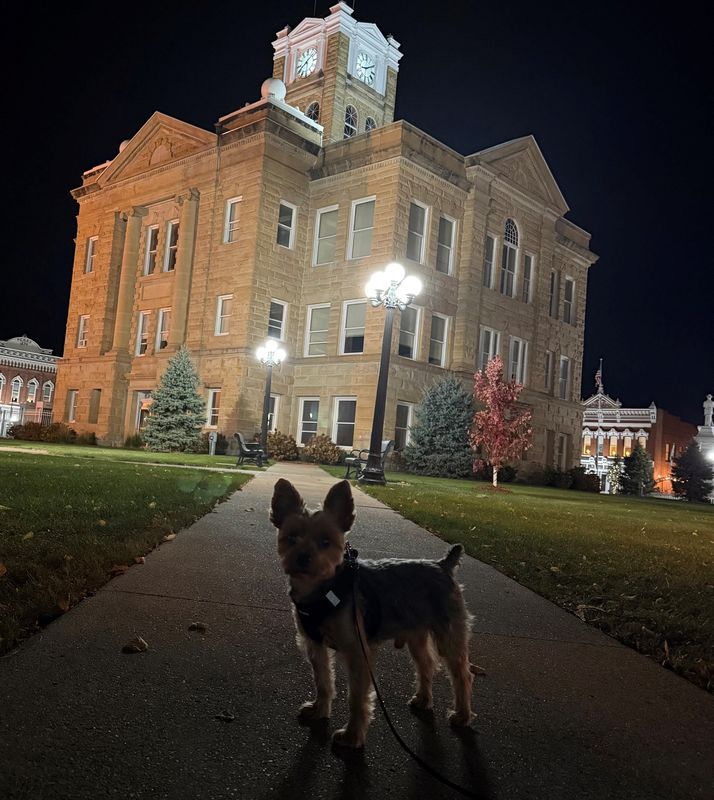While visiting John Steinbeck’s museum in Salinas, California, I stumbled upon the camper he used during his travels through the U.S. I was stunned. Steinbeck named the camper Rocinante, in honor of the horse of Don Quixote, the questing knight created by Miguel de Cervantes in the early 17th century. More importantly, Steinbeck journeyed through America with his poodle Charley, traveling almost 10,000 miles. He described his experiences in Travels with Charley: In Search of America, published in 1962, the year he was awarded the Nobel Prize in literature.

The idea of traveling with a furry four-legged companion has haunted me since and my exploration of Iowa with my Yorkie Watson is an homage to both Steinbeck and the countless dogs immortalized in literary masterpieces, from the Homeric Odysseus’ faithful Argos to Levin’s intuitive hunting dog Laska, brilliantly depicted by Tolstoy in Anna Karenina. Readers familiar with my book 13 Notes from Napoleon, Iowa: Musings on the Edge of the French Empire are aware of Watson’s ongoing forays into Europe’s Napoleonic battlefields.
Recent visits to Iowa’s Mills, Montgomery, Adams, Union, Clarke, Lucas, Monroe, Wapello, Jefferson, and Henry counties offered yet another chance to place Iowa’s development in the broader context of U.S. history. It was also an opportunity to connect with iconic American landmarks such as the American Gothic window in Eldon (Wapello County). Grant Wood’s 1930 painting was inspired by the Carpenter Gothic style farmhouse, with its now world-famous window featured prominently in the background of one of the most consequential paintings of the 20th century. It was completed in Wood’s studio in Cedar Rapids (Linn County), now housed at the Art Institute of Chicago.
Corning (Adams County) invites an encounter with another iconic American personality, Johnny Carson, TV host and comedian. His memorable “The Tonight Show” introduction, “Heeeere’s Johnny,” inspired the sign in front of the house where he was born in 1925: “Heeeere’s Johnny Carson’s Birthplace.”
All these counties reflect the evolution of American history, from Jefferson County (1839) named after Thomas Jefferson, third president of the U.S., to Monroe County (1843), after James Monroe, fifth president of the U.S., and Adams County (1853), after both John Adams, second president of the U.S., and his son John Quincy Adams, the sixth president.
Montgomery County (1851) commemorates Richard Montgomery, the American Revolutionary War general killed during the invasion of Quebec City in 1775. Mills County (1851) honors Major Frederick Mills, who was killed in 1847 at the Battle of Churubusco during the Mexican-American War (1846-1848). Pre-Civil War (1861-1863) tensions prompted the naming of Union County (1851), a plea for national unity on the eve of the most deadly U.S. war, which claimed over 600,000 lives.
Union County, along with Mills County, played a crucial role in the western migration of the Mormon settlers who, after leaving Nauvoo, Illinois, established communities in Iowa, eventually finding a permanent home in Utah.
Several of the counties reflect the history of Iowa, which was a part of the Michigan Territory in 1834, the Wisconsin Territory from 1836 to 1838, and established as a separate territory in 1838 and a state in 1846. Henry County (1836) was named after General Henry Dodge, the governor of Wisconsin Territory. Lucas County (1846) honors Robert Lucas, the first governor of the Iowa Territory, whose home, Plum Grove, is located in Iowa City (Johnson County) and is listed on the U.S. National Register of Historic Places. Clarke County (1846) references James Clarke, the third governor of the Iowa Territory.
The county seat of Clarke County, Osceola, pays tribute to the Florida Seminole leader Oceola (1804-1838), the hero of Thomas Mayne Reid’s 1858 novel Osceola the Seminole, which I read in a Russian translation in my teens. Iowa’s native history is also reflected in the name of Wapello County (1843), named after the Meskwaki chief Wapello (c. 1787-1842). The name of the county seat, Ottumwa, comes from the Meskwaki language and refers to the rolling waters of the Appanoose Rapids of the Des Moines River.
Indian Hills Community College, located in Ottumwa, operates the Fairfield Carnegie Library, the Richardsonian Romanesque-style prototype project, which served as a model for the Andrew Carnegie-endowed community-based libraries throughout the U.S. and around the globe. A total of 101 Carnegie public libraries and seven academic libraries were constructed in Iowa between 1892 and 1917. The Maharishi International University, founded in 1971, is located in Fairfield (Jefferson County).
Nine counties to go.
Professor Anna Barker teaches in the University of Iowa College of Liberal Arts and Sciences Russian Program and in the Ul Tippie College of Business Marketing. Her 2024-2025 Substack commentary focuses on the works of Dostoevsky, Dumas, and Jókai Mór. Her past tutorials exploring the intersection of history, art, and literature in works such as Gilgamesh, Paradise Lost, Les Misérables, War and Peace, Anna Karenina, and Brothers Karamazov can be found at Anna Barker’s Classics Reading Series (Iowa City UNESCO City of Literature).
This article originally appeared on Iowa City Press-Citizen: Iowa’s 99: From Mills County to Henry County | Guest Column
Reporting by Anna Barker, Special to the Press-Citizen / Iowa City Press-Citizen
USA TODAY Network via Reuters Connect



